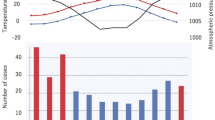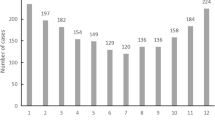Abstract
Although a number of studies have demonstrated seasonal variations in acute cardiovascular events, the association between winter and low temperatures and the incidence rate of acute aortic dissection has not been fully elucidated. In this study, we investigated the association between meteorological and chronobiological factors and the occurrence of acute aortic dissection classified by the Stanford type, sex and age. We retrospectively collected 131 patients who had been admitted consecutively to our institution with acute aortic dissection, including 58 type A patients and 73 type B patients, from January 2013 to December 2017. The meteorological data were downloaded from the homepage of the Japan Meteorological Agency. The daily incidence of aortic dissection was higher in winter (10.2%) than in fall (5.3%) (P = 0.04), and a significant winter peak was also observed in the sub-groups of males and type B, while there were no significant differences in the proportions of type A, female, and ≤ 70- and > 70-year-old patients. The maximum, mean and minimum temperatures on the days with aortic dissection were significantly lower than on the days without aortic dissection. Divided into four seasons, lower temperatures were found only in spring. The most significant and greatest difference was observed between the maximum temperature on the day of aortic dissection and that at 2 days earlier. The multivariate logistic regression analysis showed that the difference in the maximum temperature between the day of and 2 days before the incident (odds ratio 0.91; 95% confidence interval 0.87–0.96; P < 0.01) as well as the maximum temperature (odds ratio 0.97; 95% confidence interval 0.95–0.99; P = 0.02) were significantly associated with the incidence of aortic dissection. Cold weather and a sudden decrease in temperature might trigger aortic dissection, although the influence might differ among sub-groups.



Similar content being viewed by others
References
Nienaber CA, Clough RE (2015) Management of acute aortic dissection. Lancet 385:800–811
Manfredini R, Fabbian F, Manfredini F, Salmi R, Gallerani M, Bossone E (2013) Chronobiology in aortic diseases—“is this really a random phenomenon?”. Prog Cardiovasc Dis 56:116–124
Takagi H, Ando T, Umemoto T (2017) Meta-analysis of seasonal incidence of aortic dissection. Am J Cardiol 120:700–707
Majd P, Madershahian N, Sabashnikov A, Weber C, Ahmad W, Weymann A, Heinen S, Merkle J, Eghbalzadeh K, Wippermann J, Brunkwall J, Wahlers T (2018) Impact of meteorological conditions on the incidence of acute aortic dissection. Ther Adv Cardiovasc Dis 12:321–326
Karangelis D, Daskalopoulos M, Giamouzis G, Koufakis T, Fragoulis S, Papadakis E, Kalafati G, Tsilimingas N (2014) Acute aortic dissection is independent of weather conditions but statistically correlates with day of the week. J Emerg Trauma Shock 7:244
Mehta RH, Manfredini R, Hassan F, Sechtem U, Bossone E, Oh JK, Cooper JV, Smith DE, Portaluppi F, Penn M, Hutchison S, Nienaber CA, Isselbacher EM, Eagle KA (2002) Chronobiological patterns of acute aortic dissection. Circulation 106:1110–1115
Sadamatsu K, Takase S, Sagara S, Ohe K, Nishi J, Tashiro H, Kosuga T, Yasunaga H (2018) Initial medical management in acute type A aortic dissection patients with a thrombosed false lumen in the ascending aorta combining intramural hematoma and retrograde dissection from the descending to the ascending aorta. Eur Hear J Acute Cardiovasc Care. https://doi.org/10.1177/2048872618777724
Japan Medical Association Japan Medical Analysis Platform. https://jmap.jp/. Accessed 13 Feb 2019
Japan Meteorological Agency. https://www.data.jma.go.jp/gmd/risk/obsdl/index.php. Accessed 23 Jan 2018
Atsumi A, Ueda K, Irie F, Sairenchi T, Iimura K, Watanabe H, Iso H, Ota H, Aonuma K (2013) Relationship between cold temperature and cardiovascular mortality, with assessment of effect modification by individual characteristics: Ibaraki Prefectural Health Study. Circ J 77:1854–1861
Kanda Y (2013) Investigation of the freely available easy-to-use software “EZR” for medical statistics. Bone Marrow Transpl 48:452–458
DeAnda A, Grossi E, Balsam L, Moon M, Barlow C, Navia D, Ursomanno P, Ziganshin B, Rabinovich A, Elefteriades J, Smith J (2015) The chronobiology of stanford type A aortic dissections. Aorta (Stamford) 3:182–186
Law Y, Chan YC, Cheng SW (2017) Influence of meteorological factors on acute aortic events in a subtropical territory. Asian J Surg 40:329–337
Alpérovitch A, Lacombe JM, Hanon O, Dartigues JF, Ritchie K, Ducimetière P, Tzourio C (2009) Relationship between blood pressure and outdoor temperature in a large sample of elderly individuals: the three-city study. Arch Intern Med 169:75–80
Manfredini R, Boari B, Manfredini F, Salmi R, Bossone E, Fabbri D, Contato E, Mascoli F, Gallerani M (2008) Seasonal variation in occurrence of aortic diseases: the database of hospital discharge data of the Emilia-Romagna region, Italy. J Thorac Cardiovasc Surg 135:442–444
Kumar N, Pandey A, Venkatraman A, Garg N (2015) Seasonality in acute aortic dissection related hospitalizations and mortality in the United States: a nationwide analysis from 2004–2011. Int J Cardiol 179:321–322
Suzuki T, Isselbacher EM, Nienaber CA, Pyeritz RE, Eagle KA, Tsai TT, Cooper JV, Januzzi JL, Braverman AC, Montgomery DG, Fattori R, Pape L, Harris KM, Booher A, Oh JK, Peterson M, Ramanath VS, Froehlich JB (2012) Type-selective benefits of medications in treatment of acute aortic dissection (from the International Registry of Acute Aortic Dissection [IRAD]). Am J Cardiol 109:122–127
Akutsu K, Yoshino H, Shimokawa T, Ogino H, Kunihara T, Takahashi T, Usui M, Watanabe K, Tobaru T, Hagiya K, Shimizu W, Niino T, Kawata M, Masuhara H, Watanabe Y, Yoshida N, Yamamoto T, Nagao K, Takayama M, Aoki J, Taketani T, Takyama T, Tanaka M, Kinoshita K, Iwata H, Doi S, Fukui R, Yamashita H, Otsubo S, Sekine K, Watanabe N, Aoki A, Doi K, Takanashi S, Suzuki K, Mizuno A, Misumi H, Ishimatsu S, Minami Y, Yaguchi A, Saito K, Sasaki A, Watanabe Y, Sakamoto T, Senba H, Mitani H, Yoshihara K, Yoshihara K, Hata M, Akiyama K, Hokama Y, Shindo S, Arai T, Minamishima T, Kubota H, Yamaguchi Y, Fujimoto H, Nishimura T, Tsuchiyama T, Watanabe M, Goto H, Tara S, Morota T, Yokota H, Nakajima S, Asano R, Shoko T, Kuroki N, Ishikawa S, Hamabe Y, Tamura T, Nozato T, Yoshizaki T, Suzaki S, Tanaka S, Okada Y, Tanaka H, Otsuka T, Shimizu K, Shimizu S, Koido Y, Kurihara K, Someya T, Kawakami M, Oohira H, Nomoto K, Kubota T, Sakakibara M, Kanemura T, Tei I, Hirasawa Y, Morimoto S, Hashimoto K, Matsushita M, Shibata K, Hayama Y, Suto Y, Hosoya Y, Yamauchi H, Morimura N, Tanimoto S, Tabata H, Kohno T, Shimizu H, Ito R, Oda J, Hara H, Horai T, Kimura A, Ota H, Murata S, Saeki H, Ito S, Kato R, Tatebayashi T, Oikawa K, Kodani E, Unemoto K, Suzuki T, Shinooka T, Hachimaru T, Otomo Y, Ikenouchi H, Hayashi M, Yamashita H, Kasahara K, Momiyama Y, Osako M, Kikuno T, Ayabe S, Shibata T, Katayama T, Hosokawa J, Ishii Y, Isomura T, Murasaki S, Sawa S, Hirose M, Fujiwara Y, Iwakura T, Ui S, Takahashi Y, Mochida Y, Domae H (2019) Is systolic blood pressure high in patients with acute aortic dissection on first medical contact before hospital transfer? Heart Vessels. https://doi.org/10.1007/s00380-019-01419-9
Iwahori T, Miura K, Obayashi K, Ohkubo T, Nakajima H, Shiga T, Ueshima H (2018) Seasonal variation in home blood pressure: Findings from nationwide web-based monitoring in Japan. BMJ Open. https://doi.org/10.1136/bmjopen-2017-017351
Claeys MJ, Rajagopalan S, Nawrot TS, Brook RD (2017) Climate and environmental triggers of acute myocardial infarction. Eur Heart J 38:955–960
Wolf K, Schneider A, Breitner S, Von Klot S, Meisinger C, Cyrys J, Hymer H, Wichmann HE, Peters A, Illig T, Holle R, John J (2009) Air temperature and the occurrence of myocardial infarction in Augsburg, Germany. Circulation 120:735–742
Honda T, Fujimoto K, Miyao Y (2016) Influence of weather conditions on the frequent onset of acute myocardial infarction. J Cardiol 67:42–50
Akioka H, Yufu K, Teshima Y, Kawano K, Ishii Y, Abe I, Kondo H, Saito S, Fukui A, Okada N, Nagano Y, Shinohara T, Nakagawa M, Hara M, Takahashi N (2019) Seasonal variations of weather conditions on acute myocardial infarction onset: Oita AMI Registry. Heart Vessels 34:9–18
Benouaich V, Soler P, Gourraud PA, Lopez S, Rousseau H, Marcheix B (2009) Impact of meteorological conditions on the occurrence of acute type A aortic dissections. Interact Cardiovasc Thorac Surg 10:403–406
Pape LA, Awais M, Woznicki EM, Suzuki T, Trimarchi S, Evangelista A, Myrmel T, Larsen M, Harris KM, Greason K, Di Eusanio M, Bossone E, Montgomery DG, Eagle KA, Nienaber CA, Isselbacher EM, O’Gara P (2015) Presentation, diagnosis, and outcomes of acute aortic dissection: 17-year trends from the international registry of acute aortic dissection. J Am Coll Cardiol 66:350–358
Ryu HM, Lee JH, Kwon YS, Park SH, Lee SH, Bae MH, Lee JH, Yang DH, Park HS, Cho Y, Chae SC, Jun JE, Park WH (2010) Examining the relationship between triggering activities and the circadian distribution of acute aortic dissection. Korean Circ J 40:565–572
Zhao L, Chai Y, Li Z (2017) Clinical features and prognosis of patients with acute aortic dissection in China. J Intern Med Res 45:823–829
Nienaber CA, Fattori R, Mehta RH, Richartz BM, Evangelista A, Petzsch M, Cooper JV, Januzzi JL, Ince H, Sechtem U, Bossone E, Fang J, Smith DE, Isselbacher EM, Pape LA, Eagle KA (2004) Gender-related differences in acute aortic dissection. Circulation 109:3014–3021
Howard DPJ, Banerjee A, Fairhead JF, Perkins J, Silver LE, Rothwell PM (2013) Population-based study of incidence and outcome of acute aortic dissection and premorbid risk factor control. Circulation 127:2031–2037
Author information
Authors and Affiliations
Corresponding author
Ethics declarations
Conflict of interest
The authors declare that there are no conflicts of interest.
Additional information
Publisher's Note
Springer Nature remains neutral with regard to jurisdictional claims in published maps and institutional affiliations.
Rights and permissions
About this article
Cite this article
Sadamatsu, K., Sagara, S., Oe, K. et al. Meteorological and chronobiological factors and the occurrence of acute aortic dissection. Heart Vessels 35, 1003–1011 (2020). https://doi.org/10.1007/s00380-020-01569-1
Received:
Accepted:
Published:
Issue Date:
DOI: https://doi.org/10.1007/s00380-020-01569-1




